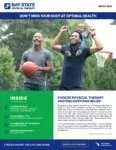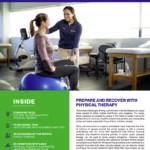Have you ever had muscle pain that was just too deep for ice or massage to help? Maybe you’ve been feeling that single point of pain in your neck or shoulder for a long period but have continued to ignore it. Perhaps you just stick with ibuprofen or other over-the-counter pain medications but are looking for a new solution to deal with your frequent aches and pains. Over time, those aches and pains can become more chronic and ultimately interfere with your ability to work, exercise, and be as active as you may want.
Learn About Dry Needling
Dry needling is a service provided by certified physical therapists utilizing a very thin needle that is inserted into the tender spot of a muscle to “trigger” a contract/relax response. When performed by physical therapists and incorporated into an individualized plan of care, dry needling can target trigger points to reduce pain and improve range of motion.
5 Dry Needling Questions You Might Have
Now’s the time to stop ignoring your pain! Physical therapists have many tools at the ready to help their patients, and one of those is called dry needling. Here are some common questions and answers about dry needling.
1. How Big Is the Needle?
Dry Needling utilizes a very fine monofilament needle to penetrate the skin and myofascial layer, commonly targeting trigger points. The needles used come in varying lengths, and your physical therapist will choose the appropriate needle based on where your trigger point is in relation to the surface of your skin.
While you may be very familiar with the needles that are used for injections or IVs, the dry needle your physical therapist uses are very different. That being said, if you want to see the needle before you try dry needling, don’t hesitate to ask your therapist to show you!
2. What’s a Trigger Point?
Myofascial knots or myofascial ‘trigger points’ are the result of the bands of tissue and muscle becoming tight or tense. While trigger points can occasionally improve on their own, left untreated these knots can lead to more significant pain. Trigger points can cause:
- Pain at the trigger point
- ‘Referred’ pain in other areas of the body region
- Muscle weakness
- Reduced range of motion
If you are dealing with any of the above symptoms, your physical therapist may recommend dry needling.
3. What’s the Science Behind Dry Needling?
Dry Needling is based on contemporary knowledge of musculoskeletal and neurological anatomy, pathophysiology, and evidenced-based research. Dry needling targets discrete, hypersensitive spots in the fascia of the skeletal muscle known as trigger points. Trigger points can be a source of longstanding pain, can limit movement, and affect function.
More simply, a very thin needle is inserted into the tender spot of a muscle to “trigger” a contract/relax response. This response stimulates oxygenated blood to be drawn to the area of the trigger point. In turn, this releases the trigger point and promotes healing.
4. What Conditions Can Dry Needling Help?
Your physical therapist will discuss your medical history and help determine if you are suitable to try dry needling. Dry needling can be beneficial for many of the conditions that physical therapists treat. Some of the most common include:
- Muscle pain in the low back
- Tennis elbow or Golfer’s elbow
- Shoulder and rotator cuff pain
- Neck pain and chronic headaches
- Hip and leg pain
- Osteoarthritis
- Sciatica
5. Will it Hurt?
When performed effectively, dry needling elicits a twitch response as the area of the muscle contracts and relaxes. Some patients describe the sensation as a short muscle cramp that quickly relaxes. Most patients say they are surprised when the muscle twitches but that it is not painful and does not hurt.
Learn More about Dry Needling
If you are injured or are dealing with pain, you are not alone. As your partner in health, Bay State Physical Therapy is just a call or click away. Contact your nearest Bay State Physical Therapy location or complete the form below to request an evaluation.
Resources:
- https://www.mayoclinichealthsystem.org/hometown-health/speaking-of-health/on-pins-and-needles-
- https://www.apta.org/patient-care/interventions/
- https://my.clevelandclinic.org/health/treatments/16542-
Tags: pain management, dry needling, trigger point, physical therapy service, Aches






